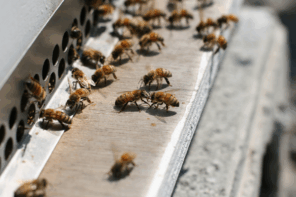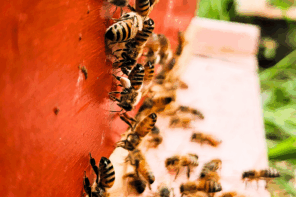By: Pat Boling
This article originally appeared in the Winter 2019 issue of BEEKeeping Your First Three Years
If you have been thinking about installing hives close to your house but thought it couldn’t be done due to space restrictions, take another look. You may find with some ingenuity and forethought, you do so successfully.
Bees don’t give a fig about space, other than the space inside their hive. They enter tiny openings in order to make their home in small, dry, spaces. Once outside that space, when foraging, Apis mellifera is quick, mobile and flies over or around all obstacles.
I live in a suburban neighborhood in coastal, West Central Florida, where I keep four active colonies, housed in ten frame, medium, Langstroth boxes. My apiary occupies an 8′ x 20′ space. Not only is that a small area, it is bordered by an 8′ high wooden, slatted fence on two sides and my house on the third. The back is open to the A/C unit and pool pump/filter and a 4′ picket fence, but could be enclosed as well, without issue.
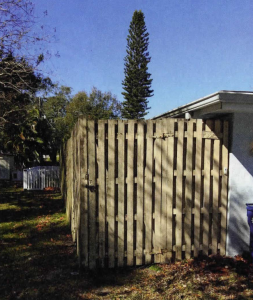
View of apiary, in formerly wasted space, from the front yard and road. This fence and the house have protected the hives from broiling sun as well as hurricanes and curious eyes.
In 2018, I harvested over thirty gallons (360 pounds) of honey from three producing hives, in July, October and December, pulls. The fourth hive, which was building from a July split and only two boxes high at year’s end, was omitted from the process.
At a recent annual outing of our bee club, The Suncoast Beekeepers Association, a long time beek saw pictures of my setup and revealed that he had been pondering utilizing a small space apiary at his house but didn’t know if it was viable.
He has several hives a few miles from his home but wanted closer colonies and had only limited space. After seeing pictures and hearing my results, he became enthused and decided to make the move to add his own small space apiary. That got me thinking that others may have doubts about putting hives in a small space also.
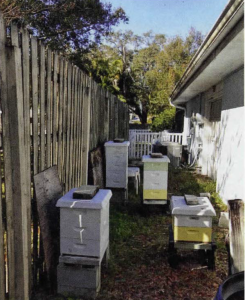
Authors 8’x20′ apiary. Note height off the ground, staggered placement and direction of hives. Also, the apiary ends several feet from equipment requiring service, in the background. The open trash can is for yard waste, not garbage.
As in all successful projects, one must plan and consider some basics before getting started. Here I have started with beginner level information but jump in anywhere your experience level warrants. I encourage you, if space is all that’s holding you back, take a closer look. You may be pleasantly surprised and well rewarded.
Basics
1. Attend a meeting of your local beekeeper’s association. These open, welcoming groups love potential members, as well as those simply interested in bees. Visitors are encouraged and they like folks currently without bees, as well as anyone thinking of becoming beeks, to sit in on meetings and ask questions. They are an invaluable resource.
2. Do an e-search for local or state regulations or restrictions regarding beekeeping. These will be your operating guidelines. In the case of Florida, the Department of Agriculture regulates bee keeping and their inspectors are an additional, helpful resource.
Your state will give all footage to hive ratios, registration information (it’s usually inexpensive to register hives) and cottage food regulations that you must adhere to, for honey sales.
Your local county or city may have apiary regulations also. Do your homework early and avoid future issues. Many governments tend to encourage apiaries and at state level, are mainly concerned with limiting the spread of disease.
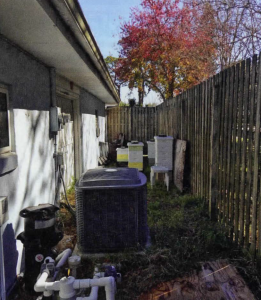
Rear view of the apiary, that occupies a small portion of the available space. Hives facing east, with serviceable equipment on the west, allow maintenance technicians a buffer.
3. Once you know how many hives you can legally keep, consider how many you should begin with. I suggest two at a minimum, to compare growth, attitude, honey and brood production, as well as have resources to react to problems if one colony gets into trouble. Don’t overload yourself to begin with or push the limits of your space.
4. Choose and source your equipment and your bees. Here you can lean on the association members for guidance to dependable and many times, local options. Once you have the equipment selected, determine if you want to buy package bees, nucs, or trap your colonies from the clear blue sky.
When choosing your bees, my suggestion is, go with nucs, which are ready made mini hives, with a mated, laying, queen, a few thousand bees and up to five built out frames. They are also usually local bees, which can be an advantage. All you do is bring them home and transfer the frames to full-size eight or ten frame boxes, when you are ready.
Package bees come via USPS, in a cage with three pounds of bees and a mated, but not laying, queen. The bees and queen have not met prior to being added to the package, just before shipment. If this is your only option, take it, but beware, the queen may not be accepted, nor have been properly mated. If she is accepted and well mated, the colony still must begin building what a nuc already possesses, built out frames and a working colony. It will require weeks or months longer to build comb, lay and hatch brood.
The third option, trapping your own, is a valid way to add to your apiary, but as a starter hive, it’s riskier than a nuc, as they aren’t established with comb, etc., but is a step ahead of the package option, as they have a known, usually laying, queen and are rip roaring to build. I’ve found swarms to be a hardy, hardworking bunch.
Be advised, there is no guarantee that you will catch anything in your traps, but it’s also amazing how many bees are looking for new homes. Trapping is fun and swarms can grow quickly into a productive hive.
Now that you have your options selected, where to put the hives?
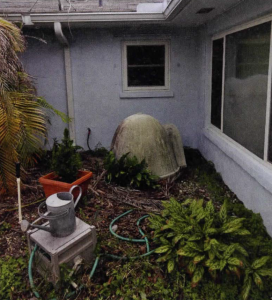
An unused, overlooked space like this could easily accommodate 3-4 hives and affords great protection from wind.
Location and Surroundings
Small area placement is just like real estate. It is all about location, location, location. Look for alcoves, little used through-ways, corners and back areas of the yard or spots adjacent to the garden. Any space large enough to house the number of hives you want with an area of 3′-4′ to move around in, should do the trick.
Florida law restricts me to six hives, based on my home lot size of just over 1/3 acre. I have four in my compact space and constantly fight the urge to add a couple more. If I do and place them in the same area, I will have to make sure my A/C technician is bee friendly. Mine currently is, as his father kept bees, but people leave jobs, so be careful when placing hives around anything that requires service.
I gift, a nicer word than bribe, everyone that does work for me with honey. It has never failed to make friends and start conversations.
Check regulations for requirements. Florida, in residential areas, requires a fence, hedge, or some other obstruction, forcing the bees to fly higher than human head level on hive entry and exit, or have set backs from property lines which keep potential confrontations with pedestrians and neighbors to a minimum.
Bees that fly up and over an obstacle like a fence, tend to stay at that height for a fair distance, unless there is a food source close to the obstacle. Hive opening placement a few feet from a fence will force them to head up quickly and stay there in flight, as well as return the same way. Mine look like fighters leaving and approaching the deck of an aircraft carrier.
Foraging bees, on a mission, are gentle unless messed with. Usually they mind their own business by flying away from trouble.
If you have colonies somewhere in the yard, without a barrier and have small children or pets, you may encounter an unwelcome issue at some point. Curiosity, mischievousness, or simply innocently bumping into the hive can cause the girls to get testy, so handle the placement with care.
Your lawn professional may not care much for an unguarded hive entrance either and give wide berth with his loud equipment. If the whole idea was not to mess with yard work in the first place, this will be a big consideration for proper safeguards.
A fence, or flight barrier, also provides “invisibility” from the street, neighbors or passersby. Having colonies hidden in plain sight is a definite respite from potential issues, both real and imagined.
Choosing a suitable location with a barrier, makes it safe for those that don’t want to wear protective clothing to use the yard. Leave about 4′ in front of the hive opening. If necessary, they can work with a little less.
Hives are best worked from the side or rear, not from the front, which is directly in the girl’s flight pattern, so placement on one side can be close to a fence, hedge or wall without issue, while buying valuable space to work in between boxes.
Hives can be placed side by side, or staggered, can face different directions and should ideally be raised off the ground, in consideration of rising water and four legged pests. Your back, when lifting full boxes of bees or honey, will thank you for getting them higher also.
As a rule, hives shouldn’t be in long hours of heavy shade, especially if you live in the deep south, where small hive beetles thrive. Pick a location that allows for a decent amount of direct sunlight.
My colonies don’t get full sun all day long, but in this neck of the woods, I don’t consider that a penalty. In northern climates, the sun hitting a hive early in the day helps the bees get up and out asap, which you want to happen. In Florida, our heat has them out on the surface of the hive day and night for most of the year, no alarm clock needed.
A house, fence or both, additionally provide an excellent wind break, which can be crucial in cold regions where icy winds and drifting snow are big problems for cold blooded insects.
I don’t see snow, or icy winds, do suffer tropical storms and hurricanes. My hives have been through five tropical storms or events and two hurricanes since 2015 with zero damage. Even our regular thunderstorms can result in straight line winds of up to 80mph, which have wreaked havoc on my banana trees, snapping some of them in half. I’ve had a greenhouse flattened, but beehive damage…nada.
Added Benefits
Having hives near the house does a couple things to make beekeeping more enjoyable and help me participate more often.
My location is never faced with a dearth (lack of nectar), so I need to pull honey at least three times a year. If I had to travel a distance to do so, things may not happen as they should. Keeping my colonies close helps eliminate obstacles to successful beekeeping.
Since they sit just feet from my tightly lidded garbage cans, it’s fun to watch the activity for a few minutes every day. This is a big plus over remote hives for spotting potential issues. Observation without interfering can give you lots of information.
A word of advice, if your Spidey senses tell you something is up…INVESTIGATE. When I don’t, I usually regret it. You will notice when something changes. That is the time to act and open them up.
Also, it is simple to gear up and take everything those few feet, for hive inspections, maintenance and harvesting. No packing, transporting by vehicle, unpacking and worst of all, realizing an essential tool or gear has been left behind. When you trek a few feet, not a few miles, it’s no big deal. Almost dummy proof.
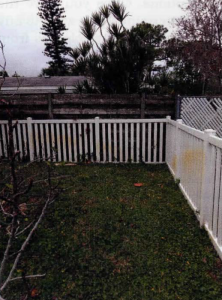
A backyard corner niche can be a perfect location. While open on two sides, the other two afford wind and flight protection, while remaining easy to work. Four or more hives could live here.
There is readily available water (another state requirement), power, lighting and thankfully, cool drinks available. Cool drinks, when the temps are way over 90F, the sun is blazing and your Kool suit is soaked with sweat, can’t be close enough. If the heat becomes intolerable, retreat to the air-conditioned house for a bit, recharge and resume.
Lastly, the immediacy of hives eliminates the urge to procrastinate, when work needs to be done. There is no lengthy pre and post preparation or travel time, when the hives need attention. Trust me, bees do their thing on their schedule. We must work on their timeline in order to be successful, not the other way around.
My ready-in-minutes honey house, a converted darkroom, itself converted from half a garage, and its proximity to the hives, complete with a dedicated freezer ready to accommodate full or spun boxes of frames, is also a blessing.
Putting honey bees in a formerly wasted, small space, close to your house, where you see them daily, with tools at one’s fingertips, and excuses few, can add to the joy and simplicity of bee keeping. Give it a try.








